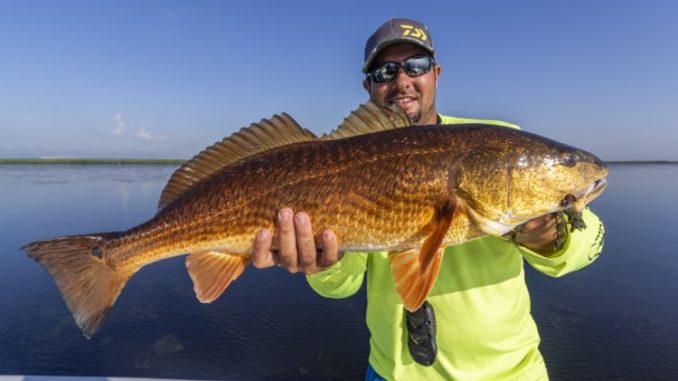
Get out early to catch redfish on Delacroix’s flats
The sun was just above the horizon, peaking from behind building thunderheads, when Capt. Austin Plaisance brought his Blazer Bay off plane. Redfish scattered across the grassy flat, pushing submarine wakes.
The owner of Louisiana Redfish Outfitters, Todd “Marsh Man Masson” Masson and I grabbed rods, and sent lures out in all directions. Plaisance was soon wrestling a big, bronze beast through the thick vegetation.
“There’s another one with it,” Plaisance called out. Masson headed for the front deck to try and pick off the following fish.
He made several casts, but to no avail.
Soon, Plaisance was digging a bull red out of the grass and dragging it aboard.
After it was photographed and released, Masson boated a smaller redfish.
Followed by another giant that fell for Plaisance’s spoon.
I finally got into the act with a beautiful red after I switched to a Bomber Who Dat Rattling Spoon.
Mixed in were some fiesty bass.
When the redfish seemed to get wise and disappeared, Plaisance simply cranked the main motor and moved to another area of the huge flat. Again redfish scattered.
And, again, we picked off fish. By this time everyone on the boat was rigged up with gold spoons.
This run-and-gun approach is how the young guide loves tracking down redfish. Sure, the fish spook as the boat plows through the water, but Plaisance said that’s not a huge problem.
“They’ll settle down,” he said.
He simply puts down his trolling motor, chases down redfish waking through the open areas of vegetation and uses a weedless spoon to provoke strikes.
“Just run (the spoon) up to a fish and drop it right in front of its face,” Plaisance explained. “It might take a twitch or two to get it to commit.”
The cool thing about these flats is that the water often is that beautiful root beer-clear, allowing you to see the bright, bronze fish.
Meaning reds often can be seen engulfing lures. The temptation can be to set the hook as soon as the lure disappears, but Plaisance said that’s a mistake.
“I usually give it about 3 seconds (before I) set the hook on it,” he explained.
This gives the fish time enough to swallow the lure and turn, so a hookset pushes the hook into the the mouth instead of pulling it free.
Indeed, several times I missed hooksets when I watched a fish race up to my flashing spoon and suck the lure into its mouth — even though I actually felt the strike.
Waiting, on the other hand, resulted in the lure being almost in the fish’s crunchers.
“He choked on it,” Plaisance said while digging out his spoon from one red’s throat.
Redfish are everhwere in the system, but it’s really not necessary to make long runs. Grassy flats surrounding Spanish Lake, Sun Lagoon, Lost Lake and Grand Lake hold mobs of reds.
Timing your trips for a falling tide will be best, and early is even better because of the summer heat.
“I think the fish pull out into the deeper channels when the water temperatures get higher,” Plaisance said.
Sure enough, the wakes disappeared by about 10 a.m.
But that was OK, since we were heading back to the launch with satisfied grins.


